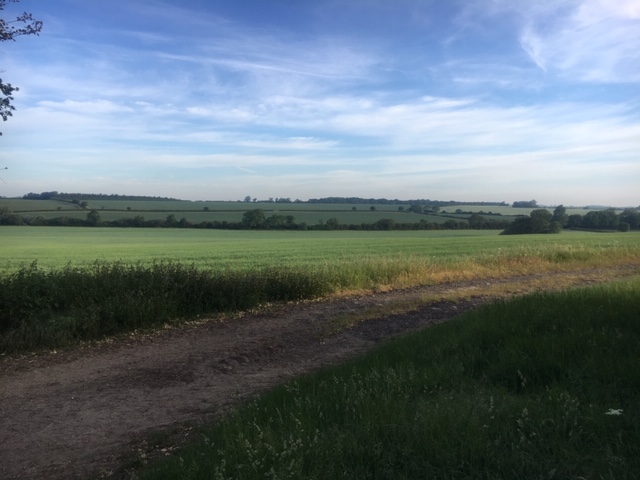
This morning, early, I paid a visit to the workplace of one of my favourite farmers: Duncan Farrington’s place down the road from me, the home of the Mellow Yellow range.
Those who have read the last chapter of A Message from Martha might have guessed what my visit was about, and yes, I was looking and listening for Turtle Doves, and no, I didn’t see or hear any. But there may be some lurking around – they are quite elusive when at low densities.
But it was a lovely walk with 28 species entered onto Birdtrack, including my first Lesser Whitethroat of the year (Lockdown, you know) and Yellowhammer, Yellow Wagtail, Linnets and lots of Skylarks. There were plenty of Woodpigeons and Stock Doves, and Collared Doves around the buildings, but no purrrrrring Turtle Doves that I could hear.
Duncan is a LEAF farmer and I always learn a lot talking to him – we met briefly as I got back to the car and had a quick chat about how he is increasing soil carbon on the farm, how the farm had no rain at all in May (and could it come quickly please?) and about how we’d both be really pleased if either of us found a Turtle Dove.
I’ve made visits here to look for Turtle Doves on and off for c14 years. I startedas a volunteer observer for the RSPB Volunteer/Farmer Alliance project (yes, I was Conservation Director at the time but it wasn’t part of my job) and was able to tell Duncan that he had a really good range of birds on his land including one of the few remaining pairs of Turtle Dove in Northants. I don’t have those original records but my last six Birdtrack lists for Duncan’s place, all in spring, provide 42 species in all. Pretty good going compared with my not-very-far-away BBS site.
Maybe I’ll be back on other mornings listening for purrrring Turtle Doves, but I think Duncan would rather that my birding were rained off.
[registration_form]
Heartening to hear of such a wonderful walk – 28 species!! – am keeping fingers’ crossed for the sound of purring TDs on your next walk! And also asking all of us nature lovers and bird watchers to show support for a fellow birder, Chris Cooper in NYC, whose own birding walk 6 days ago had a very different outcome – see https://youtu.be/_VR7oCdWB_w
Thanks Mark – Victoria
Victoria – hi there! you mean a bit like this https://markavery.info/2020/06/01/black-birders-week-blackbirdersweek/ ?
Yellow Wagtail and Lesser Whitethroat have not made my year list yet either, nor of course has Turtle Dove but then these days I don’t really expect it to, isn’t that depressing.
Hi Mark, we have a pair of turtle doves at Otmoor. Up to ten days or so ago they were turring quite regularly. However just recently they have gone quite quiet which we very much hope is a sign they are on a nest breeding. Let’s hope any on your farm are doing the same thing,
Alan – Otmoor is a very reliable site for this species isn’t it? Not many of them, but they keep coming back.
That’s right, Mark
Without being critical I fail to understand why the RSPB spends lots of time and money on reintroducing more or less several species such as WTE, Cranes, Red Kites, Cirl Buntings, Ospreys and others which I must add I enjoy and they have done a very good job but a relatively small amount of money and considerable effort could mean the difference between Turtle Doves surviving in UK or disappearing.
Dennis – what exactly is your evidence for ‘lots of time and money’ and ‘small amount of money’ please?
I think Turtle doves are going to have a hard time finding weed seed this year especially in this dry part of East Anglia. We usually have turtle doves purring around here but not this year.
We are part of the RSPB supplementary feed project but the field we are feeding on has gone brown. Last year the field was pink with doves foot cranesbill and storksbill but this year even the teasels are stunted and wilting.
The feeding is certainly helping the stock doves, they have not discovered the garden feeders this year. It also keeps the Crows busy so I suppose they are not looking for other food if they are walking around the field.
andrew – interesting observations. We have rain forcast for today but none has arrived yet.
Mark, well for sure In my opinion the same money and effort was put into helping Turtle Doves as the vast amount of both of those that was put into the 4 WTE that are supposed to return to IOW then we would improve Turtle Dove numbers.
Except for moaning then conservationists do not really seem to bother about a ordinary bird, they seem to want the dramatic birds like the WTE.
Then of course I do not follow the scientific views that seem so popular.
Dennis – as far as I know (and I don’t know everything) the RSPB hasn’t spent any money on the IoW WTE reintroduction, but they have spent aq lot o money on Turtle Dov recovery. If you have a copy of A Message from Martha you can learn of work they were doing back in 2013 (last chapter).
I am not saying it was RSPB that spent that money but for sure that amount of money and employed people put to the benefit of Turtle Doves would have been to the Turtle Doves benefit.
It was simply an example as you seemed to want excessive details whereas a ordinary countryman does not deal in such details.Maybe you have less enthusiasm for Turtle Doves countrywide than for four WTE flying around England almost anywhere except IOW.